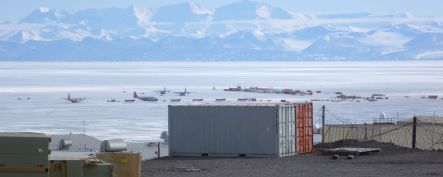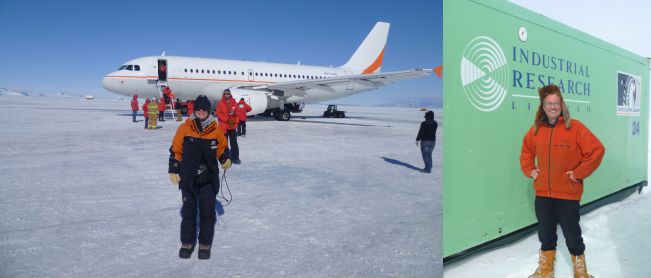Our Changing World for Thursday 27 January 2011
Alcohol and Exercise
After a big game on a Saturday night, it's usual for team mates to go to the pub and drink up big. For most sports people, once the hangover has passed, it's back to the gym on Monday or Tuesday to start training again.
 According to Matthew Barnes from Massey University, that combination of alcohol after strenuous exercise doesn't mix at all well. He tested healthy males, by damaging the quadriceps muscles of each leg on separate occasions using a machine called an isokinetic dynamometer, and participants then drank either orange juice, or alcohol. Muscle performance was measured a few days later, and the study found that performance decreased significantly after drinking the alcohol. Matthew Barnes puts Ruth Beran through her paces to show her why he recommends that people who play sports involving eccentric muscle work should avoid alcohol after a match.
According to Matthew Barnes from Massey University, that combination of alcohol after strenuous exercise doesn't mix at all well. He tested healthy males, by damaging the quadriceps muscles of each leg on separate occasions using a machine called an isokinetic dynamometer, and participants then drank either orange juice, or alcohol. Muscle performance was measured a few days later, and the study found that performance decreased significantly after drinking the alcohol. Matthew Barnes puts Ruth Beran through her paces to show her why he recommends that people who play sports involving eccentric muscle work should avoid alcohol after a match.
A participant on the isokinetic dynamometer.
Small Sharks in Estuaries

Christy Getzlaff measures the length of an adult rig, and Malcolm Francis observes a large conger eel caught in a baited pot (images: M. Francis, left, and A. Ballance, right)
It's been a bumper summer for shark sightings, and next month NIWA scientists are heading out into estuaries around the country in the hope of seeing even more sharks. Specifically, they are looking for a small shark that is officially known as rig, but which also gets called spotted dogfish, spotted smoothhound, and, in fish and chip shops, lemonfish. Estuaries are important as breeding grounds for rig, and as nursery and feeding grounds for juvenile rig, which spend a few months there after hatching before heading out into open water. The survey hopes to determine the health of rig populations, and clarify which estuaries are nursery grounds, by seeing how many young rig they catch. The survey will also provide a snapshot of the health of estuaries, as it is expected that healthy estuaries will be home to more healthy populations of rig than polluted or sediment-filled estuaries.
Adult rig are known to feed on crabs, and Massey University student Christy Getzlaff hopes to find out what the young rig eat while they are in the estuaries by looking at their stomach contents.
Alison Ballance joins NIWA principal scientist Malcolm Francis, boat skipper Peter Notman, technician Warrick Lyon and student Christy Getzlaff during a pilot survey in Porirua Harbour, as they try to determine whether set nets or pots baited with crab meat are the most effective way of catching rig.
Our Changing World featured an earlier rig survey in Pauatahanui Inlet to collect genetic samples for a comparative study of Australian and New Zealand rig populations.

Crabs are the main component of the diet of adult rig, and Warrick Lyon with an 'opera house' pot, which proved an ineffective way of catching juvenile rig (images: A. Ballance left, and M. Francis, right)
Boys' Brains

Kirstie Morgan in her office with a participant in the study (image: William van der Vliet)
In terms of height, weight, and maturity, boys obviously differ from girls, but there are also more subtle differences, like behaviour.
Until now these differences have been attributed to the levels of testosterone at birth and puberty, but could there be other hormones at work, such as anti-müllerian hormone?
Ruth Beran meets University of Otago's Ian McLennan and Kirstie Morgan who have been studying these subtle differences as well as measuring levels of different hormones in the blood, with some interesting initial results.
With both Marsden and FRST funding, the two researchers are collaborating with Department of Psychology's Ted Ruffman and David Bilkey, and their work may have potential therapeutic implications.
Antarctica - Physics of Sea Ice

From spring until early December, when the sea ice begins to break up, the sea ice in front of McMurdo Station serves as an ice runway strong enough to land C17 planes on (image: A. Ballance)
At the end of 2010, Alison Ballance spent several weeks at Scott Base in Antarctica, finding out about the varied science programmes that are supported by Antarctica New Zealand. She went from nearly the summit of Mount Erebus, out onto the sea ice and into the southern Dry Valleys in search of scientists working on topics ranging from microbes living in thermally heated soils, to fish leech antifreeze and quantifying the dust that blows onto the sea ice each year. This Antarctic Science series will play over the next few months, and kicks off tonight with a story about the physics of sea ice.
The formation of sea ice around Antarctica each winter nearly doubles the size of the frozen continent, and is one of the largest annual geophysical events on the planet (rivalled in size by another Antarctic phenomenom, the ozone hole). In just a few months the sea ice can develop thicknesses of more than 2 metres, and is strong enough for planes to land on - from September to early December planes as large as a C17 land on a sea ice runway directly in front of McMurdo Station.
Tim Haskell is a Distinguished Scientist at IRL, and recipient of the 2006 New Zealand Association of Scientist's Marsden Medal and the 2008 Antarctic medal. In 2009 a significant Antarctic strait lying under the permanent McMurdo Ice Shelf, about as wide as Cook Strait and up to 900 metres deep in places, was named Haskell Strait in his honour. He has been studying the physics of sea ice for 30 years, and Alison catches up with him at his research camp on the sea ice to hear how he got involved in sea ice research, and what he finds interesting about it. Tim Haskell collaborates closely with various university teams as well as NIWA.

Alison Ballance, upon arrival in Antarctica, with the Airbus on which she travelled sitting on the sea ice runway, and Tim Haskell at his sea ice field camp on his 1000th day 'on ice' (images: A. Ballance)